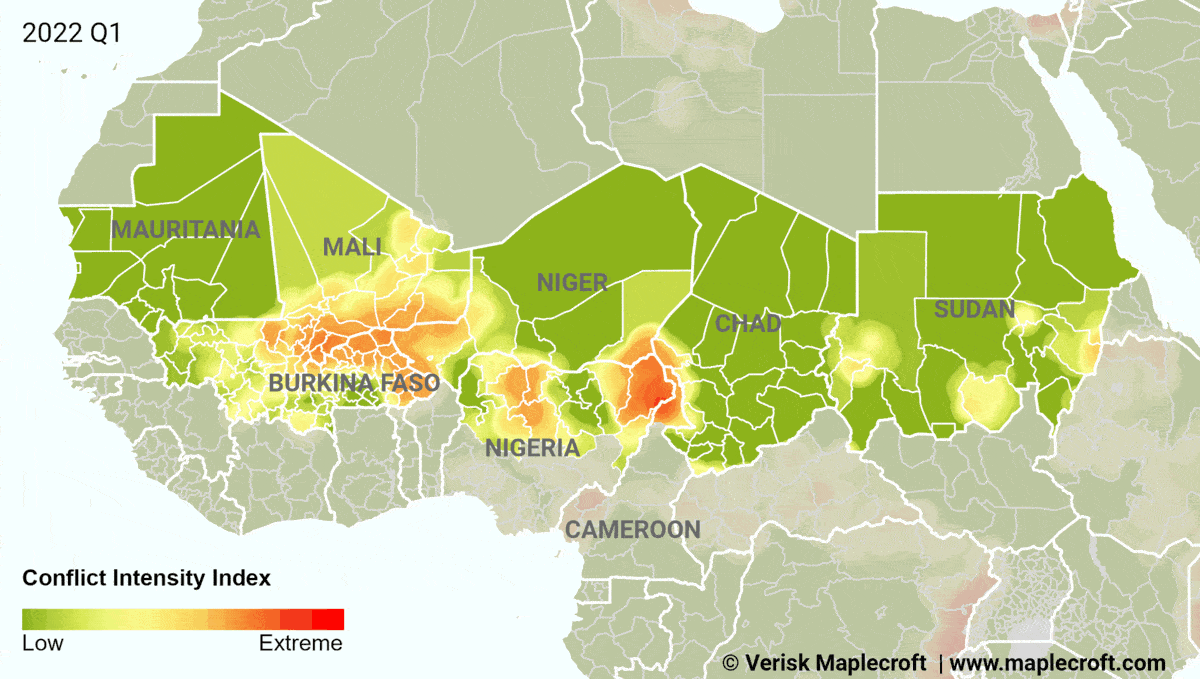The Trendline - Global political risk at highest level in five years
by Jess Middleton,
Instability underpins risk environment in 2023
After two years in which the Covid-19 pandemic served as the primary source of global instability, the conflict in Ukraine was the main driver of risk in 2022. As a result, political risk at the start of 2023 is at the highest global level we’ve seen in the last five years, according to our data combining Conflict Intensity, Civil Unrest and Government Stability.
Russia’s invasion sparked an upheaval of geopolitical norms that had existed since the end of the Cold War and the fallout will continue well into the foreseeable future. Runaway inflation and the rapid reshaping of the global energy system, both of which combined to fuel an unprecedented rise in socioeconomic tensions, will remain key factors in 2023.
In this insight, we analyse the latest data from our suite of 170+ Country Risk Indices to examine the trajectory of risk over the past year, highlighting the key signals that will shape the global risk environment in the next 12 months.
Conflict returns to centre stage
Unsurprisingly, Ukraine saw the sharpest annual uptick in risk on our Conflict Intensity Index, which measures the severity of armed conflict in a given region. Ukraine is now the 5th highest risk country on the index, down from 24th at the start of the year. Russia, meanwhile, has fallen to 26th highest risk, down from 33rd in Q1-2022.
But looking beyond Europe shows that 2022 was a year defined by conflict at a global level. 26 countries saw a significant uptick in risk on the index over the past year, compared to just three across 2021.
The ongoing civil war in Myanmar saw the country downgraded to 3rd highest risk in the index, down from 12th at the start of the year. Ethiopia’s sharp deterioration – down to 12th from 20th – is also a result of civil conflict, although there are hopes that the Ethiopia-Tigray peace agreement will arrest this decline. Elsewhere in Africa, Burkina Faso and Mali each fell three positions to 4th and 11th highest risk respectively, evidence of the Sahel’s downward spiral into instability and conflict.
“The fallout from armed conflict will remain a key risk trend for corporates, investors and insurers in 2023,” says Verisk Maplecroft’s Head of EMEA Research, Hugo Brennan. “The war in Ukraine is likely to escalate as both sides prepare for spring offensives; conflict and insecurity will continue to destabilise pockets of Africa; and interstate tensions risk tipping over into fighting in parts of the Caucasus, Central Asia and the Balkans.”
Runaway inflation sparks rise in state interventionism
The turmoil brought about by the war in Ukraine and Western efforts to break the dependence on Russian energy have contributed to rising inflation on the price of staple foods and energy. Indeed, 75 countries saw a significant uptick in risk on our Inflation Index in 2022, which measures the rate of CPI inflation for a country relative to historical rates among regional economic peers. 52 countries now receive the worst possible score of 0.00, including the likes of the United States, the United Kingdom and Germany.
Efforts to shield consumers from surging prices have resulted in a wave of state interventionism. This is particularly apparent in Europe, where 25 of the 27 EU member states witnessed a significant uptick in risk on our Resource Nationalism Index (RNI) over the past year. Germany, which in September placed a subsidiary of Russian oil firm Rosneft under trusteeship of the state regulator, fell from 142nd to 40th highest risk on the index - the largest annual downgrade registered by any country since the RNI launched in 2012.
“The cost-of-living crisis is forcing Western governments to take unprecedented steps to protect consumers and domestic industries,” adds Brennan. “2023 will be a year where respect for free markets takes a back seat to state intervention and industrial policy in Brussels, London, Washington and beyond.”
Figure 2: Energy crisis sparks rise of resource nationalism in Europe
Socioeconomic pressures build as economic and political security upended
This upheaval added fuel to social and political pressures that had simmered since the outbreak of the pandemic. Data from our Civil Unrest Index shows that 48 countries registered a significant uptick in risk throughout 2022, the biggest ever annual rise recorded in the index. The impact of this was felt worldwide, stretching from Europe – where farmer protests roiled the Netherlands, France and Italy – through to emerging markets including Sri Lanka, Peru and Kenya.
This unrest has had a tangible impact on political stability. In July, protests driven by socioeconomic unrest forced the resignation of the Sri Lankan president. The event contributed to Sri Lanka’s 64 position downgrade on our Government Stability Index (GSI) in 2022, down to 20th highest risk. A total of 25 countries registered a significant uptick in risk on the GSI throughout the year, including Pakistan, Serbia, Italy and Peru.
As shown by the unrest seen in Brazil and Peru in January, socioeconomic pressures that simmered throughout 2022 are likely to boil over in the year ahead. “As the social pressure cooker proves increasingly unable to contain the discontent of populations facing protracted economic hardship, the frequency and magnitude of the backlash against political institutions will remain near boiling point throughout 2023,” says Verisk Maplecroft’s Chief Analyst, Jimena Blanco. “It is likely no region will be spared, but the Americas will be particularly hard hit.”
Figure 3: Global civil unrest risks hit a five-year high
Little progress made on human rights in key sourcing markets
Supply chain due diligence laws, such as the US Uyghur Forced Labour Prevention Act and the German Supply Chain Due Diligence Act (LkSG), have added to an increasingly complex human rights regulatory landscape over the past year. But while businesses with global supply chains are having to adapt to a far more stringent legal era, our data shows that little progress is being made when it comes to tackling human rights abuses at ground level.
China, for example, fell two positions to 13th highest risk in our Modern Slavery Index over the past year, its highest position since the dataset launched in 2016. India meanwhile fell seven positions, down to 21st highest risk in the index. Vietnam, Cambodia, Pakistan and Mexico also registered downgrades, highlighting the uphill battle faced by businesses looking to minimise their exposure to human rights risks in major sourcing countries.
“Worsening economic conditions inflate modern slavery risks and expose businesses to greater reputational and legal challenges,” says Sofia Nazalya, Senior Human Rights Analyst at Verisk Maplecroft. “Companies that approach human rights due diligence as a box-ticking exercise are unlikely to meet the stringent requirements arising out of emerging EU legislation. To be on the front foot for the year ahead and beyond, businesses must make informed sourcing decisions that depend on credible data.”
Environmental regulations tighten, but outlook remains bleak
Wildfires in Western Europe, drought in the Horn of Africa and record floods across the Indian subcontinent all served as a painful reminder of the escalating climate crisis in 2022. Commitments made during COP27, and at its biodiversity counterpart COP15, have raised hopes that more will be done in terms of government policy and financing to tackle climate change and habitat loss.
Our datasets suggest that governments are beginning to act on implementing more stringent environmental regulations. Take our Environmental Regulatory Framework Index, where 19 countries registered a significant improvement in the past year, compared to just one that registered a significant deterioration. At the same time, 101 countries sit within the two highest risk categories of Carbon Policy Index, which measures the likelihood and ability of countries to bring in more stringent emission reduction policies.
But slow progress on policy is not enough to deal with the rapidly escalating physical threats we all face: half of the world’s population – some 3.9bn people – now live in areas rated high or extreme risk in our latest Climate Change Vulnerability Index, with huge implications for societies, economies and global supply chains.
“Governments and regulators will continue to move to address climate and natural capital risks in 2023, whether by introducing more stringent laws and policies affecting operations or mandating greater transparency from organisations around the risks and opportunities they forecast in the future,” says Verisk Maplecroft’s Head of Climate and Resilience Will Nichols. “Corporates and investors will need to anticipate these trends to ensure they can effectively navigate stakeholder requirements.”
Cutting edge data key to understanding a rapidly evolving risk environment
2022 laid bare the tight interconnections that exist between political, social and environmental risks. Heading into 2023, businesses that embed cutting-edge risk data and analytics in their strategies and processes stand the best chance of minimising their exposure to both short- and long-term threats in what is an increasingly complex risk environment.


